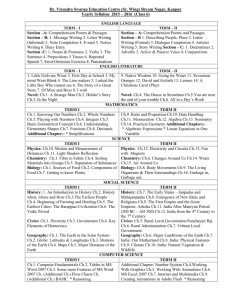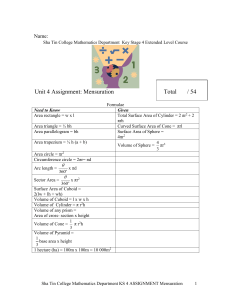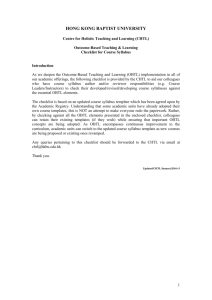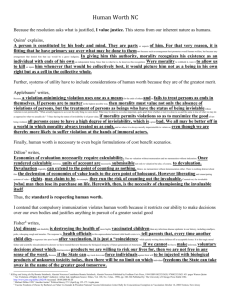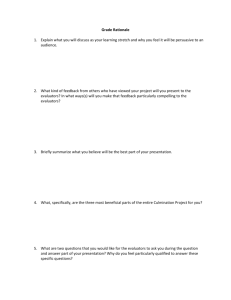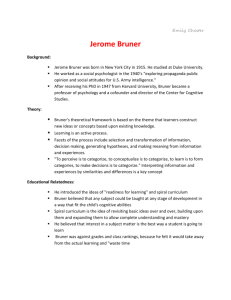proposed teacher's guide in solid mensuration with - ICME-12
advertisement
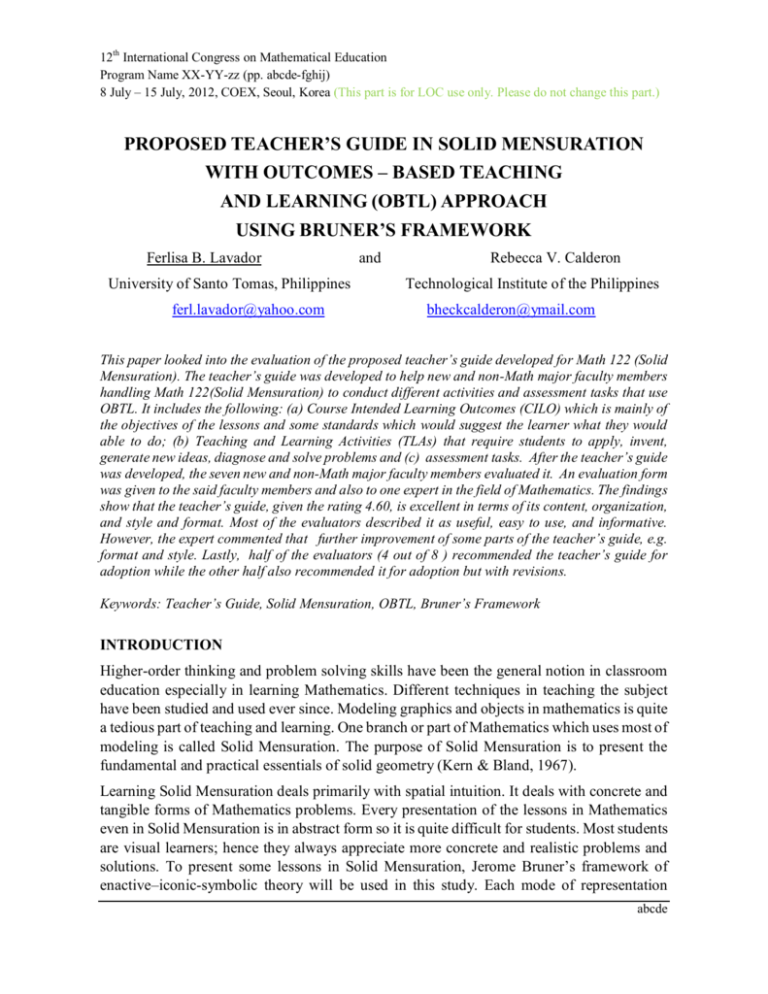
12th International Congress on Mathematical Education Program Name XX-YY-zz (pp. abcde-fghij) 8 July – 15 July, 2012, COEX, Seoul, Korea (This part is for LOC use only. Please do not change this part.) PROPOSED TEACHER’S GUIDE IN SOLID MENSURATION WITH OUTCOMES – BASED TEACHING AND LEARNING (OBTL) APPROACH USING BRUNER’S FRAMEWORK Ferlisa B. Lavador University of Santo Tomas, Philippines ferl.lavador@yahoo.com and Rebecca V. Calderon Technological Institute of the Philippines bheckcalderon@ymail.com This paper looked into the evaluation of the proposed teacher’s guide developed for Math 122 (Solid Mensuration). The teacher’s guide was developed to help new and non-Math major faculty members handling Math 122(Solid Mensuration) to conduct different activities and assessment tasks that use OBTL. It includes the following: (a) Course Intended Learning Outcomes (CILO) which is mainly of the objectives of the lessons and some standards which would suggest the learner what they would able to do; (b) Teaching and Learning Activities (TLAs) that require students to apply, invent, generate new ideas, diagnose and solve problems and (c) assessment tasks. After the teacher’s guide was developed, the seven new and non-Math major faculty members evaluated it. An evaluation form was given to the said faculty members and also to one expert in the field of Mathematics. The findings show that the teacher’s guide, given the rating 4.60, is excellent in terms of its content, organization, and style and format. Most of the evaluators described it as useful, easy to use, and informative. However, the expert commented that further improvement of some parts of the teacher’s guide, e.g. format and style. Lastly, half of the evaluators (4 out of 8 ) recommended the teacher’s guide for adoption while the other half also recommended it for adoption but with revisions. Keywords: Teacher’s Guide, Solid Mensuration, OBTL, Bruner’s Framework INTRODUCTION Higher-order thinking and problem solving skills have been the general notion in classroom education especially in learning Mathematics. Different techniques in teaching the subject have been studied and used ever since. Modeling graphics and objects in mathematics is quite a tedious part of teaching and learning. One branch or part of Mathematics which uses most of modeling is called Solid Mensuration. The purpose of Solid Mensuration is to present the fundamental and practical essentials of solid geometry (Kern & Bland, 1967). Learning Solid Mensuration deals primarily with spatial intuition. It deals with concrete and tangible forms of Mathematics problems. Every presentation of the lessons in Mathematics even in Solid Mensuration is in abstract form so it is quite difficult for students. Most students are visual learners; hence they always appreciate more concrete and realistic problems and solutions. To present some lessons in Solid Mensuration, Jerome Bruner’s framework of enactive–iconic-symbolic theory will be used in this study. Each mode of representation abcde Lavador and Calderon corresponds to a developmental stage of learning. According to Bruner (1967), any domain of knowledge could be represented in three ways or modes: by a set of actions (enactive representation), by a set of images or graphics that stand for the concept (iconic representation); and by a set of symbolic or logical statements (symbolic representation). Teaching Solid Mensuration is not as easy as giving a lecture. The instructor must be equipped with the knowledge and skills needed in facilitating the activities of the said course. Moreover, the inclusion of Outcomes-Based Teaching and Learning (OBTL) is a new developmental task in giving lectures and activities. Biggs and Tang (2006) affirmed that OBTL starts with clearly stating, not what the teacher is going to teach, but what the outcome of that teaching is intended to be in the form of a statement of what the learner is supposed to be able to do and at what standard: the Intended Learning Outcome (ILO). When students attend lectures, however, their main activity is receiving, not doing. Hence we need to devise Teaching and Learning Activities (TLAs) that require students to apply, invent, generate new ideas, diagnose and solve problems—or whatever other things they are expected to be able to do after they graduate (Biggs & Tang, 2006). Similarly we need Assessment Tasks (ATs) that tell us, not to how well students have received knowledge, but how they can use it in academically and professionally appropriate ways, such as solving problems, designing experiments, or communicating with clients. In this institution, problems arose on how to teach and facilitate students’ learning in Solid Mensuration especially when the reference books are outdated and the resource materials are limited. The task of the instructors is not only to impart knowledge but also to facilitate students’ discoveries of new knowledge and applying it in real-life situations. It is in this note that the study of developing a teacher’s guide that will include OBTL with an injection of Bruner’s Framework in teaching and learning Solid Mensuration will be created. This may help the instructor to handle the subject. It may help the teachers to assess some applied and higher order outcomes in solving problems. Objectives of the Study This study mainly aimed to develop Teacher’s Guide in Solid Mensuration with OUTCOMES-BASED TEACHING AND LEARNING (OBTL) Approach using Bruner’s Framework. Specifically, the study seeks to achieve the following objectives: 1. To develop a teacher’s guide in Solid Mensuration that will provide activities with OBTL including the Intended Learning Outcomes, Teaching Learning Activities and Course Intended Learning Outcomes. 2. To use the framework of Jerome S. Bruner to the development of the teacher’s guide. 3. To provide additional teaching materials aside from the book of Solid Mensuration that is outdated. Abcde+3 ICME-12, 2012 Lavador and Calderon RELATED LITERATURE REVIEWS AND CONCEPTUAL FRAMEWORK This chapter presents a review of related literature and studies focused on three main areas specifically, (a) Solid Mensuration (b) Outcomes-Based Teaching and Learning (c) Bruner’s Framework and the Conceptual framework of the study Solid Mensuration The notions, facts, and problems studied in Solid Mensuration are, perhaps, less sophisticated compared to those considered in plane geometry, but for the successful passage from the plane to space, students must develop a new skill, spatial imagination (Dubrovsky, 2004). Studying three-dimensional geometry is much more realistic than any branch of Mathematics. But much of our work in three-dimensional geometry will consist of reducing problems to two-dimensional situations in which students already know how to handle. In studying Solid Mensuration, students must have a prerequisite on Algebra and Trigonometry. It is more useful to study this course if the students knew well the Plane Geometry. Most of the problems in Solid Mensuration would be better understood if it is related to objects of everyday experience. Kern and Bland (1967) suggested that solving Solid Mensuration problems require thought and visualization. The problems must stimulate the student’s imagination and developing his space intuition. In doing so, the research would try to develop a teacher’s guide that will promote the concrete form, images and abstract form of Solid Mensuration problems and activities. Outcomes-Based Teaching and Learning (OBTL) Outcomes-Based Teaching and Learning (OBTL) is a new approach in teaching and learning the course or the subject matter. OBTL is based on such questions as: What do I intend my students to be able to do after my teaching that they couldn’t do before, and to what standard? How do I supply learning activities that will help them achieve those outcomes? How do I assess them to see how well they have achieved them? (Biggs & Tang, 2006). As its name suggests, OBTL starts with clearly stating, not what the teacher is going to teach, but what the outcome of that teaching is intended to be in the form of a statement of what the learner is supposed to be able to do and at what standard: the Intended Learning Outcome (ILO). When students attend lectures, however, their main activity is receiving, not doing. Hence we need to devise Teaching and Learning Activities (TLAs) that require students to apply, invent, generate new ideas, diagnose and solve problems—or whatever other things they are expected to be able to do after they graduate. Similarly we need Assessment Tasks (ATs) that tell us, not to how well students have received knowledge, but how they can use it in academically and professionally appropriate ways, such as solving problems, designing experiments, or communicating with clients. It is often difficult to assess these applied and higher order outcomes in the examination room context (Biggs and Tang, 2006). In teaching Solid mensuration, constructive alignment is very useful. Constructive” refers to the idea that students construct meaning through relevant learning activities; “alignment” refers to the situation when teaching and learning activities, and assessment tasks, are aligned to the Intended Learning Outcomes by using the verbs stipulated in the ILOs. ICME-12, 2012 abcde+2 Lavador and Calderon The reason that OBTL is applied here in our institution is that OBTL is logical, effective and both teachers and students find it more satisfying than traditional teaching. A benefit for students, possibly even more than teachers, is that the ILOs tell them precisely not only what they are supposing to be learning, but how and to what standard. In other countries, OBTL is used for quality assurance and to ensure the enhancement of teaching and learning. According to Biggs and Tang (2006), to be maximally effective, OBTL requires a change from a quantitative and analytic mindset that does atomize knowledge into marks to one that uses and grades assessment tasks qualitatively and holistically wherever possible. High level outcomes, academic or professional, refer to whole acts, not to the independent components of those acts. Assessing the components of a task is very helpful in providing feedback to students, but ultimately students have to be assessed holistically in a way that is authentic to their discipline. Thus, in teaching Solid Mensuration, it is but appropriate to use OBTL approach. Bruner’s Framework The enactive - iconic - symbolic theory of Bruner illustrates the three modes through which a concept presents itself to the learners. Each mode of representation corresponds to a developmental stage of learning. This theory was used in developing the teacher’s guide. The rationale for the choice of the framework is based primarily on Bruner’s three modes of cognitive development. Bruner (1966) suggests three modes of representational thought. That is, an individual can think about a particular idea or concept at three different levels. "Enactive" learning involves hands-on or direct experience. The strength of enactive learning is its sense of immediacy. The mode of learning Bruner terms "iconic" is one based on the use of the visual medium: letting the child experience the manipulatives and transforming them into pictures. "Symbolic" learning is that stage where one uses abstract symbols to represent reality. In here the experiential learning with the use of pictures and representations is transformed into a learning theory of abstract form, e.g. equations. Bruner feels that a key to readiness for learning is intellectual development, or how a child views the world. Bruner (1973) suggested that readiness depends more upon on effective mix of these three learning modes than upon waiting until some imagined time when children are capable of learning certain ideas. Throughout his writing is the notion that the key to readiness is a rich and meaningful learning environment coupled with an exciting teacher who involves children in learning as a process that creates its own excitement. Bruner (Beyond the Information Given, 1973) stated that learning mathematics reflects a good deal about intellectual development. It begins with instrumental activity, a kind of definition of things by doing them. Such operations become represented and summarized in the form of particular images. Finally, with the help of a symbolic notation that remains invariant across transformations in imagery, the learner is able to grasp the formal or abstract properties of the things he is dealing with. Presenting Solid Mensuration would be much more appreciated using the said framework. It is more appropriate to start learning using real materials, the tangible in form, a more concrete way of studying some solid figures which are basically the focus of the course. Once concrete Abcde+3 ICME-12, 2012 Lavador and Calderon operational mode is used, images and drawings can be visualize by the students and can easily present these. These images and drawings can be transformed into symbols and abstract in form which are very much used in teaching and learning any Mathematics. Thus Bruner’s framework is may be of help in developing teacher’s guide in Solid Mensuration. Conceptual Framework Figure 1: Research Paradigm The need for a development of teacher’s guide was realized due to the problems and suggestions given by Mathematics instructors and the need of application of technology in teaching and learning. After careful planning and testing alternative activities, development of the teacher’s guide for Solid Mensuration has started. Initial validation will be conducted to students who are taking Math 122 course. This will be followed by the expert’s feedback, e.g. experienced Mathematics instructor. Also, it will be evaluated by the new Solid Mensuration instructor. Then finally, a validated teacher’s guide in Solid Mensuration with OBTL Approach will be made. METHODOLOGY Project Development The study aimed to respond on some problems in teaching Solid Mensuration. Due to lack of resources and outdated book, this study was created. In this study, the problems and suggestions of Math 122 (Solid Mensuration) instructors for several years were noted. The teacher guide would serve as an alternative resource material in teaching Solid Mensuration. The new approach that was used in this study was OBTL following the pattern of Bruner’s Framework. The second phase was the formulation of teacher’s guide in Solid Mensuration. The teacher’s guide was composed of (a) Course Intended Learning Outcomes (CILO) which is mainly of ICME-12, 2012 abcde+2 Lavador and Calderon the objectives of the lessons and some standards which would suggest the learner what they would able to do; (b) Teaching and Learning Activities (TLAs) that require students to apply, invent, generate new ideas, diagnose and solve problems and assessment tasks. In here, the lesson proper is properly introduced with OBTL approach. The coverage of the lessons in Solid Mensuration was from the Plane Figures up to the Mean Volume of the Solids. Different learning activities and group works was given according to the Intended Learning Outcomes (ILO); and lastly we needed (c) Assessment Tasks (ATs) that tell us, not to how well students have received knowledge, but how they can use it in academically and professionally appropriate ways, such as solving problems, designing experiments, or communicating with clients. These tasks mainly focused on exercises, seatworks, group works, quizzes and assignments. The students and teachers accomplished these tasks. Testing and Operating Procedures Once the teacher’s guide was created, teaching with OBTL approach was employed by the instructor. The CILO, TLAs and ATs were put into practice for the students to follow and be able to come up with learning outcomes. Exercises and seatworks were given after each lesson given. The results of exercises and seatworks gave feedback to the instructor if the lesson was properly delivered and the OBTL approach was appropriately used. Also, verbal and written feedbacks from the students were taken into account for the duration of the project. After the initial copy of the teacher’s guide, it underwent evaluation from the peer instructors and one expert. Then after evaluation, revisions was undertaken to finalize. Evaluation Sampling Techniques Purposive sampling technique was used in this study since it was focused to innovative activities with OBTL approach using Bruner’s framework in Solid Mensuration for students. In Technological Institute of the Philippines, Quezon City (TIP–QC), one class which was composed of 30 students, taking Math 122 for School Year 2010 – 2011 was selected for the pilot- testing. TIP – QC instructors who are handling Math 122 were selected as evaluators. For the expert , the chair of the Math and Physics department served as the evaluator. Research Instrument A teacher-made evaluation form was used which is based on the existing textbook/workbook evaluation tools of some schools. It consists of two parts, the evaluation of the teacher’s guide on the three criteria: content, organization, and style and format. The second part is focused on the personal rating, adjectival description, comments and action for recommendation of the instructor and experts. To gauge the perception of students in Solid Mensuration, interview schedule was given to the students. Descriptive Statistics was used to find the overall evaluation score of the instructors and expert. Abcde+3 ICME-12, 2012 Lavador and Calderon RESULTS AND DISCUSSIONS This chapter contains the presentation of the gathered data from evaluation forms given to the respondents and their analysis and interpretations. The results were summarized and presented in tables. After the teacher’s guide was developed an evaluation by the new and non-Math major instructors were conducted. The experts’ opinion on its content and construction was also used. Table 1: Evaluation of the Teacher’s Guide by Instructors and Expert (Part I) Evaluators Rating Instructor 1 4.35 Instructor 2 5.00 Instructor 3 5.00 Instructor 4 4.21 Instructor 5 4.57 Instructor 6 4.85 Instructor 7 5.00 Expert 3.78 Weighted Mean 4.60 Description Excellent The table above shows the evaluation of the new and non-Math major instructors who were handling Math 122 (Solid Mensuration) classes, and one experts in the field of teaching Mathematics. This part of their evaluation was focused on three categories: content, organization, and style and format. It is shown in the table that all of (7 out of 7) instructors think that the teacher’s guide was excellent while the expert gave the rate of 3.78, which was also excellent. Overall, the teacher’s guide was excellent in terms of content, organization, and style and format. The second part of the evaluation asks the evaluators how much of the teacher’s guide would they used, what rating would they give to it, and what adjective/s is/are appropriate to describe the teacher’s guide. Based on the responses of the instructors, 4 out of 7 said that they would use partly, but a lot, while the expert said all of it. In fact all of them have read the whole teacher’s guide. ICME-12, 2012 abcde+2 Lavador and Calderon When the evaluators were asked about the overall rating that they would give to the teacher’s guide, 7 out of the 8 evaluators gave the rating of excellent. The other 1 rating was good. In terms of adjectival descriptions of the teacher’s guide, the table below shows the summary of the 7 evaluators’ responses: Table 2: The Adjectives Chosen by the Evaluators to Describe the Teacher’s Guide Adjectives Frequency Percentage Useful Clear Timely Easy to Use Informative Concise 7 4 4 8 7 1 87.5 50 50 100 87.5 12.5 It is shown on the table above that 8 out of the 8 evaluators or 100% chose the adjectives easy to use, to describe the teacher’s guide. Seven of them( 87.5%) said it is useful and informative, half of them thought it is clear and timely (50 %) and only one said it is concise (12.5%). In the comment section of the evaluation form, one of the instructors commented, “The guide is very useful especially to those who are not Math major.” The expert who evaluated the teacher’s guide, commented, “ Very Good”. Lastly, the evaluators were asked if they would like to recommend the teacher’s guide for adoption, for adoption but with revision, or not recommend it for adoption. Table 3 below shows the summary of their responses: Table 3: Recommendation of the Evaluators for the Teacher’s Guide Recommendation Frequency Rate (%) Recommended for adoption 4 50 Recommended for adoption with revision 4 50 Not recommended for adoption 0 0 Total 8 100 Four out of the 8 evaluators or 50% recommended the teacher’s guide for adoption, while the other 50%, also recommended it for adoption but with some revisions. None of the evaluators (0%) would not recommend the teacher’s guide for adoption. Abcde+3 ICME-12, 2012 Lavador and Calderon SUMMARY OF FINDINGS, CONCLUSIONS AND RECOMMENDATIONS After all the data and results are presented and analyzed to answer the main problem of the study, this chapter summarizes all the findings, derive the conclusion from these findings and formulate recommendations for further improvement of the study. Summary of Findings The following findings are based on the evaluation given by seven (7) new and non-Math major instructors handling Math 122 ( Solid Mensuration) classes and one expert in the field of teaching Mathematics. 1. The teacher’s guide was given the weighted mean rating of 4.60 or excellent for its content, organization, and style and format. 2. The over-all rating given to the teacher’s guide is excellent and good. 3. In general, the guide was described as useful, easy to use, and informative. 4. Some of the comments aside from its usefulness are on further improvement of its format. 5. Four of the evaluators (50%) recommended the teacher’s guide for adoption while the other four also recommended it for adoption but with revisions. Conclusion The evaluation given by the new and non-Math major instructors and expert in the field of teaching the subject directs the study to a conclusion that the teacher’s guide is useful, easy to use and informative enough for adoption. Some of the revisions from the comments given must be taken into account for further improvement of the teacher’s guide. Recommendations The following recommendations may further improve the results of the study: 1. Further validation must be conducted since it was not completely done in this study. 2. Same study may be conducted in other Mathematics subjects. 3. Instructors/teachers must be encouraged to make compilation of the lecture notes, comments and /or suggestions which they can use in making of a teacher’s guide or a module that may help others. 4. Further improvement of the format and other activities of the teachers’ guide may be done. REFERENCES Adams, S & Powell, MJ (1994). Classroom Compass: Cooperative Learning. Southwest Consortium for the Improvement of Mathematics and Science Teaching, Volume 1, Number 2 pp. 1-10 ICME-12, 2012 abcde+2 Lavador and Calderon Biggs, J & Tang, C. Outcomes-Based Teaching and Learning(OBTL), What is it, Why is it, How do we make it work? Retrieved September 11, 2010, Website: http://drjj.uitm.edu.my/DRJJ/OBE%20FSG%20Dec07/OBEJan2010/Biggs-n-Tang-OBT L-preworkshop.pdf Bruner, J., Olver, R., Greenfield, P. & et. al. (1966). Studies in cognitive growth: A collaboration at the Center for Cognitive Studies. New York: Wiley & Sons, Inc. Bruner, J. (1973). Beyond the Information Given. New York: Norton. Burghes, D.N. Mathematics enhancement Program, Primary Demonstration Project Help Module 7A: Mensuration. Retrieved December 9, 2010, Website: http://www.ex.ac.uk/cimt/help/menu.htm. Comandante, F. Analytic and Solid Geometry Made Easy. Mandaluyong City: National Bookstore. Dubrovsky, Vladimir N (2004). Solid and Dynamics. Micromath- Association of Teachers of Mathematics, Volume 20, Number 3, pp. 24- 30. Geometry Tutorials. Retrieved October 31, 2010, Website: www.analyzemath.com. Kern & Bland (1967). Solid Mensuration (Second edition), New York: Wiley & Sons, Inc. Montessori, M. (1964). Dr. Montessori’s Own Handbook. Massachusetts: Robert Bentley, Inc. Outcomes-Based Teaching and Learning. Retrieved August 18, 2010, Website: http://www.bc.cityu.edu. Savage, Matthew A (1999). Outcomes- Based Teaching--Oh, That sinking feeling. The Clearing House, pp. 11-12. Abcde+3 ICME-12, 2012
